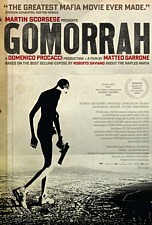
Knight at the Movies Archives
A chilling, fresh addition to the mob movie genre, 55 years later James Dean returns to Chicago one more time
By the time you read this the Oscar for Best Foreign film will have been awarded. But though the year’s contenders were a worthy
batch it’s still a head scratcher that neither A Christmas Tale, Arnaud Desplechin’s tremendous film about a dysfunctional French
family starring Catherine Deneuve and Marthieu Amalric, nor the sensational Gomorrah were among the nominees. Though A
Christmas Tale has left theatres (and don’t expect a DVD until November of ’09) Gomorrah, the eye opening look at the vicious
Italian crime organization, the world’s most violent, opens in Chicago this week.
This is no romantic portrait of the mafia ala The Godfather or decades of other mob pictures. It’s closer in spirit to "The Sopranos"
without the fabulous trappings and the emotional ups and downs. This is a stripped down, realistic venal society in which everything
is tainted by the insidiousness of the underworld. The Italian Camorrah (the word literally means “gang”), a loosely knit group of
constantly warring gangs, never took hold in America the way the Sicilian Mafia did. No one cooks spaghetti or talks about “honor”
and there’s no opera on the soundtrack in the movie. This is simply a world of unglamorous violence with death meted out quickly
and bodies disposed of just as fast (a shot of two bodies dumped in a bulldozer on a beach toward the end is unforgettable).
Based on the sensational bestseller by author Robert Saviano (who co-wrote the screenplay and remains under permanent police
protection after repeated death threats from the group), director Matteo Garrone’s film weaves together five of the most compelling
stories from the book – a work of fiction steeped in reality. The film is primarily set in a section of Naples known as the Caserta,
one of the most lawless in the world (where the film was shot). Most of the action takes place in one of those faceless, multi-leveled
concrete housing complexes with the cramped apartments facing onto a central courtyard and a skylight far overhead. But as we
watch overhead the inhabitants scurry about, some dispensing drugs to eager customers, others running from a rare police visit by
the police and dodging bullets, engaged in dropping off hush payments, or randomly doing errands, ignoring the illicit activities, the
place quickly comes to resemble rats in a maze – an earthly realization of Dante’s hellish underworld; a forgotten set from Fellini’s
decadent Satyricon.
One story follows two violent but idiotic teenagers who make the mistake of emulating the cocky bravado of the murderous drug lord
played by Al Pacino in Scarface (they are shown shouting Pacino’s lines from the movie as they are introduced). Ripping off small
time drug dealers and speeding away on a Vespa scooter is one thing but ignoring turf warnings from the district crime boss and
stealing a cache of hi-tech weapons is another. Another story follows a wide-eyed young boy of 13 who delivers groceries but yearns
to prove that he’s got what it takes to join the group. At one point he and other hopefuls willingly strap on a bullet proof vest and
take a hit to the chest at point blank range to prove their “manhood.”
Then there is a couture dressmaker whose boss is in hock to the Comorrah and counts on the tailor and the other factory workers to
work impossible hours for peanuts so he can stay in business. But the dressmaker, who takes great pride in his work, secretly
moonlights at night teaching his trade secrets to a Chinese competitor – with tragic consequences. Finally, we see a man at the top,
a sophisticated businessman who arranges to dump toxic waste for high priced client’s right in the empty lots and open fields of the
surrounding countryside, literally poisoning the earth and the inhabitants. When an accident causes the adult truck drivers to walk
off the job he doesn’t hesitate to hire a batch of fearless kids to drive the trucks filled with the toxic waste in their place.
Gamorrah is fragmented and jumps about and there’s no visual cuing as in Traffic to help the audience keep their bearings as these
stories rush by – it’s all filmed under the same sludge gray skies (even Venice has never looked so bleak) – and one has to pay
attention to keep track. Things quickly move on in this unsentimental world and the icy philosophy of the group, “We have to score,
kill and we need money” is visualized in every frame of Garrone’s cool eyed film. Though some of the stories allow us to keep our
distance it’s also clear that from the lowest human vice on up to the world of high fashion the reach of this rarely seen group is very
long indeed. Subtitled.
+++++++++++++++++++++++++++++++++++++++++++++++++++++++++++++++++++++++++++++++++++++++++++++
Director Nicholas Ray’s 1954 Rebel Without A Cause, still the benchmark for films about juvenile dissatisfaction, plays a week
long engagement beginning this Friday at the Gene Siskel Film Center. The film stars James Dean, poster child for the beautiful
and the damned, the forever 24 year-old who left just three movies behind after dying in an automobile crash in 1955 (East of Eden
and Giant were the other two). The bisexual Dean, poster boy for 50s homoeroticism (along with Montgomery Clift and Marlon
Brando) stars as the teenaged malcontent who forms a bond with gorgeous but mixed up Judy (Natalie Wood) and rich boy Plato
(Sal Mineo). Mineo’s character forms a crush on Dean and is clearly shown to be gay (he’s almost subjected to gay bashing by a
group led by Dennis Hopper) – a very daring undercurrent for a film shot over 60 years ago. Bigger Than Life, Ray’s 1956 follow-up
starring James Mason is also on the bill (and will be shown in a new 35mm print). www.siskelfilmcenter.com
batch it’s still a head scratcher that neither A Christmas Tale, Arnaud Desplechin’s tremendous film about a dysfunctional French
family starring Catherine Deneuve and Marthieu Amalric, nor the sensational Gomorrah were among the nominees. Though A
Christmas Tale has left theatres (and don’t expect a DVD until November of ’09) Gomorrah, the eye opening look at the vicious
Italian crime organization, the world’s most violent, opens in Chicago this week.
This is no romantic portrait of the mafia ala The Godfather or decades of other mob pictures. It’s closer in spirit to "The Sopranos"
without the fabulous trappings and the emotional ups and downs. This is a stripped down, realistic venal society in which everything
is tainted by the insidiousness of the underworld. The Italian Camorrah (the word literally means “gang”), a loosely knit group of
constantly warring gangs, never took hold in America the way the Sicilian Mafia did. No one cooks spaghetti or talks about “honor”
and there’s no opera on the soundtrack in the movie. This is simply a world of unglamorous violence with death meted out quickly
and bodies disposed of just as fast (a shot of two bodies dumped in a bulldozer on a beach toward the end is unforgettable).
Based on the sensational bestseller by author Robert Saviano (who co-wrote the screenplay and remains under permanent police
protection after repeated death threats from the group), director Matteo Garrone’s film weaves together five of the most compelling
stories from the book – a work of fiction steeped in reality. The film is primarily set in a section of Naples known as the Caserta,
one of the most lawless in the world (where the film was shot). Most of the action takes place in one of those faceless, multi-leveled
concrete housing complexes with the cramped apartments facing onto a central courtyard and a skylight far overhead. But as we
watch overhead the inhabitants scurry about, some dispensing drugs to eager customers, others running from a rare police visit by
the police and dodging bullets, engaged in dropping off hush payments, or randomly doing errands, ignoring the illicit activities, the
place quickly comes to resemble rats in a maze – an earthly realization of Dante’s hellish underworld; a forgotten set from Fellini’s
decadent Satyricon.
One story follows two violent but idiotic teenagers who make the mistake of emulating the cocky bravado of the murderous drug lord
played by Al Pacino in Scarface (they are shown shouting Pacino’s lines from the movie as they are introduced). Ripping off small
time drug dealers and speeding away on a Vespa scooter is one thing but ignoring turf warnings from the district crime boss and
stealing a cache of hi-tech weapons is another. Another story follows a wide-eyed young boy of 13 who delivers groceries but yearns
to prove that he’s got what it takes to join the group. At one point he and other hopefuls willingly strap on a bullet proof vest and
take a hit to the chest at point blank range to prove their “manhood.”
Then there is a couture dressmaker whose boss is in hock to the Comorrah and counts on the tailor and the other factory workers to
work impossible hours for peanuts so he can stay in business. But the dressmaker, who takes great pride in his work, secretly
moonlights at night teaching his trade secrets to a Chinese competitor – with tragic consequences. Finally, we see a man at the top,
a sophisticated businessman who arranges to dump toxic waste for high priced client’s right in the empty lots and open fields of the
surrounding countryside, literally poisoning the earth and the inhabitants. When an accident causes the adult truck drivers to walk
off the job he doesn’t hesitate to hire a batch of fearless kids to drive the trucks filled with the toxic waste in their place.
Gamorrah is fragmented and jumps about and there’s no visual cuing as in Traffic to help the audience keep their bearings as these
stories rush by – it’s all filmed under the same sludge gray skies (even Venice has never looked so bleak) – and one has to pay
attention to keep track. Things quickly move on in this unsentimental world and the icy philosophy of the group, “We have to score,
kill and we need money” is visualized in every frame of Garrone’s cool eyed film. Though some of the stories allow us to keep our
distance it’s also clear that from the lowest human vice on up to the world of high fashion the reach of this rarely seen group is very
long indeed. Subtitled.
+++++++++++++++++++++++++++++++++++++++++++++++++++++++++++++++++++++++++++++++++++++++++++++
Director Nicholas Ray’s 1954 Rebel Without A Cause, still the benchmark for films about juvenile dissatisfaction, plays a week
long engagement beginning this Friday at the Gene Siskel Film Center. The film stars James Dean, poster child for the beautiful
and the damned, the forever 24 year-old who left just three movies behind after dying in an automobile crash in 1955 (East of Eden
and Giant were the other two). The bisexual Dean, poster boy for 50s homoeroticism (along with Montgomery Clift and Marlon
Brando) stars as the teenaged malcontent who forms a bond with gorgeous but mixed up Judy (Natalie Wood) and rich boy Plato
(Sal Mineo). Mineo’s character forms a crush on Dean and is clearly shown to be gay (he’s almost subjected to gay bashing by a
group led by Dennis Hopper) – a very daring undercurrent for a film shot over 60 years ago. Bigger Than Life, Ray’s 1956 follow-up
starring James Mason is also on the bill (and will be shown in a new 35mm print). www.siskelfilmcenter.com
The Damned and the Beautiful:
Gomorrah-Rebel Without A Cause
2-25-09 Windy City Times KATM Column
By Richard Knight, Jr.
Gomorrah-Rebel Without A Cause
2-25-09 Windy City Times KATM Column
By Richard Knight, Jr.


